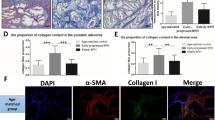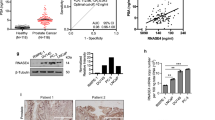Abstract
The aim of the present study was to investigate the differential expression of erythropoietin receptor (EPOR) in prostate carcinoma (PCa), high-grade prostatic intraepithelial neoplasia (PIN), prostatic hyperplasia (BPH) lesions and normal prostatic tissues by immunohistochemistry; and to test the hypothesis that upregulation of EPOR is a specific event for prostate carcinogenesis. An immunohistochemical analysis of EPOR was performed on 30 PCa, 50 BPH with/without inflammation lesions and 30 normal prostatic tissue samples. EPOR staining was quantitated and classified into normal expression and overexpression. Totally 16 high-grade PIN lesions were found in this study. Overexpression of EPOR was shown only in PCa and high-grade PIN. Statistical analysis demonstrated that higher median EPOR staining score of PCa and high-grade PIN in comparison with BPH (P<0.05) and higher median EPOR staining score of PCa compared with high-grade PIN (P<0.05). Our data demonstrate that upregulation of EPOR is not uncommon for PCa and upregulated EPOR in high-grade PIN suggests upregulation of EPOR is an early event for prostate carcinogenesis. The role of upregulated EPOR and possibly enhanced EPOR signaling in prostate carcinogenesis warrants further studying.
This is a preview of subscription content, access via your institution
Access options
Subscribe to this journal
Receive 4 print issues and online access
$259.00 per year
only $64.75 per issue
Buy this article
- Purchase on Springer Link
- Instant access to full article PDF
Prices may be subject to local taxes which are calculated during checkout


Similar content being viewed by others
References
Krantz SB . Erythropoietin. Blood 1991; 77: 419–434.
Jones SS, D'Andrea AD, Haines LL, Wong GG . Human erythropoietin receptor: cloning, expression, biological characterization. Blood 1990; 76: 31–35.
Bazan JF . Structural design and molecular evolution of a cytokine receptor superfamily. Proc Natl Acad Sci USA 1990; 87: 6934–6938.
D'Andrea AD, Fasman GD, Lodish HF . A new hematopoietic growth factor receptor superfamily: structural features and implications for signal transduction. Curr Opin Cell Biol 1990; 2: 648–651.
Livnah O, Stura EA, Middleton SA, Johnson DL, Jolliffe LK, Wilson IA . Crystallographic evidence for preformed dimers of erythropoietin receptor before ligand activation. Science 1999; 283: 987–990.
Remy I, Wilson IA, Michnick SW . Erythropoietin receptor activation by a ligand-induced conformation change. Science 1999; 283: 990–993.
Wojchowski DM, Gregory RC, Miller CP, Pandit AK, Pircher TJ . Signal transduction in the erythropoietin receptor system. Exp Cell Res 1999; 253: 143–156.
Juul SE . Nonerythropoietic roles of erythropoietin in the fetus and neonate. Clin Perinatol 2000; 27: 527–541.
Masuda S, Naguo M, Takahata K, Konosh Y, Gallyas Jr F, Tabira T et al. Functional erythropoietin receptor of the cells with neural characteristics. Comparison with receptor properties of erythroid cells. J Biol Chem 1993; 268: 11208–11216.
Moritz KM, Lim GB, Wintour EM . Developmental regulation of erythropoietin and erythropoiesis. Am J Physiol 1997; 273: R1829–R1844.
Sasaki R, Masuda S, Nagao M . Erythropoietin: multiple physiological functions and regulation of biosynthesis. Biosci Biotechnol Biochem 2000; 64: 1775–1793.
Acs G, Zhang PJ, Rebbeck TR, Verma A . Immunohistochemical expression of erythropoietin and erythropoietin receptor in breast carcinoma. Cancer 2002; 95: 969–981.
Acs G, Acs P, Beckwith SM, Pitts RL, Clements E, Wong K et al. Erythropoietin and erythropoietin receptor expression in human cancer. Cancer Res 2001; 61: 3561–3565.
Selzer E, Wacheck V, Kodym R, Schlagbauer-Wadl H, Schlegel W, Pehamberger H et al. Erythropoietin receptor expression in human melanoma cells. Melanoma Res 2000; 10: 421–426.
Westenfelder C, Baranowski RL . Erythropoietin stimulates proliferation of human renal carcinoma cells. Kidney Int 2000; 58: 647–657.
Yasuda Y, Fujita Y, Masuda S, Musha T, Ueda K, Tanaka H et al. Erythropoietin is involved in growth and angiogenesis in malignant tumours of female reproductive organs. Carcinogenesis 2002; 23: 1797–1805.
Ribatti D, Marzullo A, Nico B, Crivellato E, Ria R, Vacca A . Erythropoietin as an angiogenic factor in gastric carcinoma. Histopathology 2003; 42: 246–250.
Batra S, Perelman N, Luck LR, Shimada H, Malik P . Pediatric tumor cells express erythropoietin and a functional erythropoietin receptor that promotes angiogenesis and tumor cell survival. Lab Invest 2003; 83: 1477–1487.
Gaffen SL, Lai SY, Longmore GD, Liu KD, Goldsmith MA . Genetic evidence for an additional factor required for erythropoietin induced signal transduction. Blood 1999; 94: 74–86.
Leyland-Jones B, BEST Investigators Study Group. Breast cancer trial with erythropoietin terminated unexpectedly. Lancet Oncol 2003; 4: 459–460.
Henke M, Laszig R, Rube C, Schafer U, Haase KD, Schilcher B et al. Erythropoietin to treat head and neck cancer patients with anemia undergoing radiotherapy: randomised, double-blind, placebo-controlled trial. Lancet 2003; 362: 1255–1260.
Muller W, Burgart LJ, Krause-Paulus R, Thibodeau SN, Almeida M, Edmonston TB et al. The reliability of immunohistochemistry as a prescreening method for the diagnosis of hereditary nonpolyposis colorectal cancer (HNPCC)—results of an international collaborative study. Fam Cancer 2001; 1: 87–92.
Feldman L, Wang Y, Rhim J, Sytkowski AJ . Human prostate epithelial cells and prostate cancer cells express functional erythropoietin receptors and respond to erythropoietin in vitro. Exp Hematol 2002; 30 (6 Suppl 1): 61.
Feldman L, Wang Y, Rhim JS, Bhattacharya N, Loda M, Sytkowski AJ . Erythropoietin stimulates growth and STAT5 phosphorylation in human prostate epithelial and prostate cancer cells. Prostate 2006; 66: 135–145.
Arcasoy MO, Amin K, Vollmer RT, Jiang X, Demark-Wahnefried W, Haroon ZA . Erythropoietin and erythropoietin receptor expression in human prostate cancer. Mod Pathol 2004; 18: 421–430.
McNeal JE, Bostwick DG . Intraductal dysplasia: a pre-malignant lesion of the prostate. Hum Pathol 1986; 17: 64–71.
Acs G, Zhang PJ, McGrath CM, Acs P, McBroom J, Mohyeldin A et al. Hypoxia-inducible erythropoietin signaling in squamous dysplasia and squamous cell carcinoma of the uterine cervix and its potential role in cervical carcinogenesis and tumor progression. Am J Pathol 2003; 162: 1789–1806.
Bonkhoff H, Stein URemberger K . The proliferative function of basal cells in the normal and hyperplastic human prostate. Prostate 1994; 24: 114–118.
McNeal JE, Haillot O, Yemoto C . Cell proliferation in dysplasia of the prostate: analysis by PCNA immunostaining. Prostate 1995; 27: 258–268.
Colombel M, Symmans F, Gil S, O'Toole KM, Chopin D, Benson M et al. Detection of the apoptosis-suppressing oncoprotein bc1-2 in hormone-refractory human prostate cancers. Am J Pathol 1993; 143: 390–400.
Silva M, Grillot D, Benito A, Richard C, Nunez G, Fernandez-Luna JL . Erythropoietin can promote erythroid progenitor survival by repressing apoptosis through Bcl-XL and Bcl-2. Blood 1996; 88: 1576–1582.
Acknowledgements
This project was funded by a grant from Shanghai PuJiang Program 05PJ14005.
Author information
Authors and Affiliations
Corresponding author
Rights and permissions
About this article
Cite this article
Zhou, T., Xu, C., He, M. et al. Upregulation of erythropoietin receptor in human prostate carcinoma and high-grade prostatic intraepithelial neoplasia. Prostate Cancer Prostatic Dis 11, 143–147 (2008). https://doi.org/10.1038/sj.pcan.4500995
Received:
Revised:
Accepted:
Published:
Issue Date:
DOI: https://doi.org/10.1038/sj.pcan.4500995



